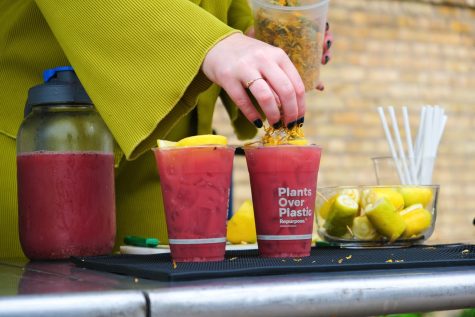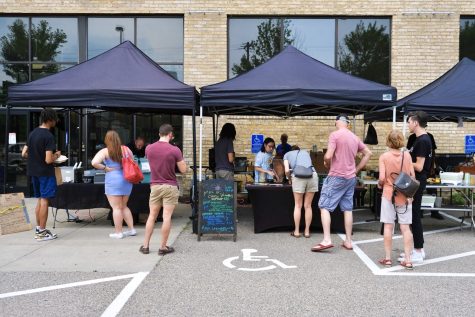Posted on 16 July 2022.
ALBERTO GOMEZ: Hi everyone, my name is Alberto Gomez and this… is a special episode of In The Know. Traditionally, we focus on stories relating to the University and communities within the immediate area, but today, we at In The Know wanted to create something a little different. Today, we will be departing from typical hard news, and instead, I want to express my opinion on the role that media has in the internet age and how it may be falling short in serving audiences.
Before going too far into this op-ed, let me properly introduce myself. As stated, my name is Alberto and I will enter my fourth year at the University of Minnesota this fall. I pursue a degree in journalism and cultural studies and comparative literature. I am a third generation immigrant, with a father and grandparents from Mexico. My family originally raised me in Waukegan, Illinois before moving to a predominately white suburb of Kenosha, Wisconsin.
I say these things for one reason. I hope to ensure that my audience understands my inherent biases that come with my background. These are things that no journalist can ever separate themselves from. I, much like any journalist, hold personal values derived from my identities and experiences and this does affect my reporting. I hope that audiences might gleem how my background may impact my reporting and hold me to a higher standard.
To me, a journalist’s duty is to the community that they serve. In this industry we call that philosophy “Communitarianism.” This philosophy puts the values and needs of the society over the individual. In other words, my own desires or that of friends come second to the needs of the community. Listeners can hear this type of philosophy at work in episodes 95 and 97, during sections explaining community desires rather than giving platform to a sole person or representative of the community. The goals of these pieces were to focus on what the people needed and wanted in the I-95 areas respectively.
In these pieces, reporter Sean Ericson and I chose to put more emphasis on community members rather than the desires and plans of government or university officials. By drawing a line between a person and the community’s experiences, we at In The Know attempt to reflect an overall problem rather than presenting things as an isolated incident with no recourse.
I recently spoke with Ruth DeFoster, a professor of journalism at the University of Minnesota. Much of her research has covered mass shootings and acts of terrorism. While comparing mass shooting coverage between Finland and the United States, she pointed out two things that she believes to be a major flaw in American media and journalism.
After a 2008 university shooting in Kauhajoki, Finland, DeFoster called attention that Finnish media outlets tried to keep the shooter’s direct actions and identity to a minimum usage, so as to prevent the shooter from gaining notoriety and risking copycats.
RUTH DEFOSTER: That was like an implicit rule in all of the newsroom that they wouldn’t use the, the shooter’s name. I don’t think you’d ever see that in the U.S. I think that’s considered highly newsworthy.
GOMEZ: The Finnish Broadcasting Company’s report on the shooting focused less on the actions of the shooter but instead on what police and government officials will be doing in response to the shooting. Conversely, the U.S. based New York Times’ report on the same incident instead focused on details of the shooting itself before moving onto public reactions.
DEFOSTER: It was all about framing, this sense of like communalism, like how are we as Fins or Suomi, which is what it is in Finland, how are we going to recover from this? How are we going to like come together as a nation and heal? How will this affect the way that the rest of Europe and the world sees us? And I just didn’t see any of that real communal perspective here in the U.S.
GOMEZ: In the United States, we view news as entertainment for current events. There is a reason why one of the most watched programs in the nation is Tucker Carlson Tonight, averaging about 3.5 million viewers as of this June, according to AdWeek. Even this is written with the intent to entertain while informing, hence the usual sound effects in the background to keep you, the listener, engaged or in the moment.
This type of coverage difference lies at the center of why In The Know tends to focus stories on community actions and persons, rather than a single issue or occurrence. I believe that focusing on stories of healing and experiences creates a community focused narrative while avoiding sensationalization.
But, I consume news as entertainment too. I listen to podcasts and news pundits or commentators everyday. But the problem is that news as entertainment tries to entertain first. Going back to the Tucker Carlson Tonight example, his comments are portrayed as news, not commentary. After all, he appears on the Fox News channel. Of course, the same applies to left-leaning commentary, such as Last Week Tonight with John Oliver. Due to their entertaining nature these programs grab audiences attention more easily than something like print journalism or even reports on The Minnesota Daily website. These shows tend to use provocative language or propose an agenda while commenting on current events. This is not unbiased and fair journalism.
I will not comment on how I perceive these two shows, it’s not relevant here. What’s more important is acknowledging that these shows present themselves as news sources, despite neither of them being explicit journalism, just commentary according to the U.S. District Judge Mary Kay Vyskocil. But these shows are easily consumed and spread. They’re successful at disseminating information, yes, but it is not unbiased journalism. If anything, they are more akin to an op-ed.
Noor Adwan works as the opinion’s desk editor at the MN Daily. She is a fourth year Palestinian-American journalism student. In April of 2021, Adwan submitted her first op-ed piece to the Minnesota Daily, detailing her arrest during a protest in Brooklyn Center. Since then, Adwan has continued her work as a columnist and opinion writer for the Daily.
NOOR ADWAN: I was really more drawn to the personality that you can put into an op-ed. And I feel like I’ve been someone who’s been doing a lot of like advocacy work throughout my life. So op-eds just kind of felt like a more natural decision for me.
GOMEZ: The Daily puts a restriction on opinion writers like Adwan, she cannot transfer to a hard news desk nor cover hard news stories because of her pre-expressed opinion writings. Ergo, everything she writes comes from her own perspectives and interpretations of facts and news, much like a talk show host putting their own “spin” on a topic. With this platform she puts effort into advocacy work, a matter that she doesn’t believe hard news can achieve as well as op-eds.
ADWAN: You can definitely accomplish advocacy through hard news. But I feel like it’s more direct with op-eds. You can directly tell people, this is what I think. Um, you don’t have to agree, but this is what I think, this is my take. So while it is possible to accomplish advocacy through hard news, I think that soft news, the soft news approach, the op-eds approach is a lot more direct.
GOMEZ: There is an importance to Adwan’s separation from hard news. The Daily does not want to risk the muddying or misinterpretation of opinions for news. So rather than feigning an objective perspective, Adwan advocates for total transparency in her writing.
ADWAN: So I think that transparency coupled with ethical, responsible journalism and being very transparent about your practices saying, “Hey, I am not an objective source.” No one is, but, but I thoroughly research, you know, everything that I write, I fact check everything. This is a really, you know, an arduous process, making sure that what I’m saying is while it’s not, you know, objective is useful information to have,
GOMEZ: To Adwan, one of the most important aspects of disseminating information is to remain earnest. When Adwan includes her perspectives and experiences in her pieces, she leaves audiences to agree or disagree with her ideas. DeFoster, though, states that journalists should remain as objective and fair as possible in their reporting. Though commentary has risen in popularity, journalists still have a duty to present good and well researched information without attempting to skew audiences.
Currently, DeFoster is working on a book that covers perceptions of terrorism. While conducting her research, she surveyed Gen Z adults to get an idea of where young people get their news.
DEFOSTER: Close to a hundred percent. It was like 98% said “social media.” We think that we’re getting our news from a much more, you know, um, diverse landscape of, of sources, but in reality, especially young people, they’re really just getting it from social media. Like, that’s where they’re encountering new information.
GOMEZ: But, there’s a problem with that. Audiences want to know as much information as possible with the least amount of effort put forward. This means less digging for good information and more clicking on whatever pops up on a user’s feed.
Open Democracy wrote in 2018 that Cambridge Analytica, a data gathering company under the supervision of former White House Chief Strategist Steve Bannon, “obtained data collected from Facebook” to “train its microtargeting algorithms to nudge scores of already-angry voters towards electing Donald Trump and leaving the European Union.” The goal of these algorithms was to keep people clicking on easily accessible and eye-catching information.
DEFOSTER: But that’s where we are! And that’s how TikTok works. That’s how Instagram works. That’s how Twitter works. The goal is to keep you clicking and what keeps people clicking the most? What, what really engages people? It doesn’t make them happy, but it’s outrage.
GOMEZ: According to Open Democracy, social media platforms try to provide information that a user will engage with, that would mean information that aligns with a user’s world views and perceptions. For example, a lover of content like Tucker Carlson will likely not engage nor watch content similar to that of CNN’s Anderson Cooper, so social media algorithms will not bring it up on a user’s feed. This creates an echo chamber effect, where users continue to engage with content that confirms preconceived notions.
This isn’t that different from receiving news on talk shows, news commentary, or casual podcasts. Curated content like these shows aim to engage and entertain first, the legitimacy of information is secondary. Some shows will of course provide more honest information, but it still remains entertainment first.
And now we come to the conundrum that journalists face. How do we get audiences to listen? Audiences don’t engage with genuine news content in the same way they may engage with Instagram or Facebook infographics or Fox News. What we write is not nearly as flashy and fun.
Honestly, the news is boring. That’s coming from someone who reads news articles for about an hour everyday. I am paid to do that and I still get bored. But my duty as a journalist asks me to remain informed and disseminate information for listeners.
I love staying informed, I enjoy news media, I have fun researching information and telling stories to people. But I have dyslexia making reading difficult. I, too, get bored of constantly reading article after article. So, what can journalists do for people in a similar boat as me?
I believe that news media should attempt to entertain and reach audiences in the middle of fun and newsworthy. Journalists need to make content that people want to engage with while still making it accessible.
I don’t think that it is enough to consume news from pundits or commentators, and I don’t think all news media must adopt that style of dissemination to remain relevant. Yes, some information is better than total obliviousness,but there comes the risk of consuming extremely skewed information if someone only listens to news commentary. Televised programs focus on keeping watchers watching, their profit comes from advertising afterall.
Journalists like myself worry that good information doesn’t reach the vast audiences that it needs to. Take for example the New York Times, one of the most read newspapers in the United States. According to a 2021 annual report, the Times has seen a slow and steady print circulation decline.
And yet, the Times hasn’t folded. I’ll admit, the previous paragraph was a partial lie. The Times does reach audiences, as a matter of fact. Online, the Times reaches 70 million unique readers every month, according to the Times’ annual report.
But the Times is an exception, not the rule. Forbes reports that 2,000 of 3,143 U.S counties do not have a daily newspaper, and 200 of those counties lack a weekly local newspaper.
As print media has begun to decline in popularity, journalism needs to adapt and find alternative ways of reaching audiences. The Times has chosen to put more efforts in publishing easy to engage content, things like podcasts and shareable Instagram infographics. While I don’t believe infographics can replace thorough journalism, at the very least it is accessible information.
As information migrates more and more to an online medium, journalism can’t sustain itself on its traditional formats. News content needs to evolve in the present moment, it must find a way to entertain and keep audiences engaged.
MPR’s News With Angela Davis is an excellent example of mixing talk show energy with newsworthy dissemination. Davis keeps her perspective and opinions to a minimum while keeping her interpretations to nothing more than explanatory. Her personality still shines through, much like a podcast episode from the likes of Joe Rogan, but she does so by not explicitly trying to interpret or guide for her audience.
When DeFoster moved to an online format to teach her classes at the University of Minnesota, she found it difficult to get students to participate in class and watch pre-recorded lectures. Unsure of what to do, DeFoster turned to her teenage son.
DEFOSTER: And he’s “like, mom, you gotta make it like YouTube. You have to, like, you gotta tell ’em a story you gotta,” and that’s what I did. And it worked. Honestly. Where I’d be in my pop culture class. I’m like, okay, I’m gonna tell you the story of Millie Vanilli and how they blew up and how they failed. And then we’re gonna get into the content. And, and it would like, you know, emulating that kind of delivery. That’s more fun. And it worked really well. I got, I got close to a hundred percent of the students watching the whole lecture.
GOMEZ: But I do worry about the intersection of entertainment and news. It might get difficult for audiences to differentiate between what’s news and what’s entertainment. Going back to the John Oliver and Tucker Carlson examples, legally both of these shows distinguish themselves as entertainment talk shows, while still covering news content. While Oliver does concede and admit to personal biases and opinions, not every content creator will do that. Nor will every reader or audience member be able to automatically distinguish between news and opinionated content. There was a reason why this episode opened very distinctly with me explaining my background and that what you are listening to is an opinion. Like Adwan explained, journalism must present itself in full transparency.
While I believe that many journalists attempt to be honest, that does not mean that every article written is not without flaw. Even this podcast has been notified of reporting errors in the past.
The duty of a journalist is to hold our institutions accountable, but who will hold us accountable? While I know it isn’t flashy, it’s up to our audiences just as much as ourselves. When we embed links in our articles, double check, inquire further into the information you receive. Learn a little background on the writer and the platforms that they write for. If you can, try to learn their sponsors to determine what possible conflicts of interests they might have. Make sure that the information they give you is being honest, earnest, fair, and balanced.
I know most listeners won’t do that, but it’s the thought that counts. Much like a journalist spends hours gathering info, audiences need to inquire too.
That doesn’t mean grow paranoid and check for moles in the media, it just means to know who speaks and what expertise a journalist has. If a journalist has a background in, say, mass shooting coverage or violent crime coverage like DeFoster, odds are they know what they are talking about to an extent. If a journalist is a Palestinian or Mexican American individual, no doubt they will share some sympathy or personal thoughts on related topics. But, this does not and should not instantly discredit or credit them. Generally speaking, most journalists want to share information earnestly; Our job is to seek the truth and report it. That’s one of our key pillars in our Code of Ethics, as described by the Society of Professional Journalists: to seek the truth and report it.
There isn’t anything wrong with listening to news pundits or commentators, but it’s important to rationalize and understand that they speak for themselves and for their opinions. In Harper Lee’s To Kill A Mockingbird, Atticus Finch tells his daughter Scout to remove the adjectives and you’ll get the facts. While the world isn’t that simple, that’s a place to start.
The Daily would like to thank all of our listeners for tuning in to this special episode. We’ll see you next time. And don’t forget to like and rate In The Know wherever you enjoy your podcasts. My name is Alberto Gomez and this is In The Know.








